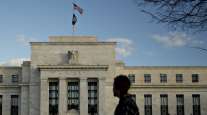US Adds 200,000 Jobs; Wages Rise by Most Since Recession

U.S. hiring picked up in January and wages rose at the fastest annual pace since the recession ended, as the economy’s steady move toward full employment extended into 2018.
Nonfarm payrolls rose 200,000 — compared with the median estimate of economists for an 180,000 increase — after an upwardly revised 160,000 advance, Labor Department figures showed Feb. 2. The jobless rate held at 4.1%, matching the lowest since 2000, while average hourly earnings rose a more-than-expected 2.9% from a year earlier, the most since June 2009.
Treasury yields and the dollar gained, while stock futures remained lower, as the data reinforced the Fed’s outlook for three interest-rate hikes this year under incoming Chairman Jerome Powell, including one that investors expect in March. The figures may also add to the likelihood of a fourth rate increase in 2018.
The report puts the nation closer to maximum employment — one of the goals of the Federal Reserve — and sets a solid tone for hiring this year following continued gains in payrolls in 2017. That could be starting to generate a long-awaited, sustained pickup in wages and boost demand in this expansion, which may also get a lift this year from tax-cut legislation signed by President Donald Trump in December.
RELATED: Companies add more jobs than forecast, ADP data show
“The gain in wages will add to concerns that inflationary pressures are building in the economy,” said Michael Feroli, chief U.S. Economist at JPMorgan Chase & Co., who correctly projected the payrolls gain. “It solidifies expectations that the Fed will hike in March. The question is, what will they signal for hikes after that?”
The Labor Department’s figures included its annual benchmark update to the establishment survey, spanning payrolls, hours and earnings over the past five years.
Average hourly earnings rose 0.3% from the prior month following an upwardly revised 0.4% gain, the report showed. The 2.9 advance from a year earlier — which partly reflected a downward revision to the January 2017 wage figure — compared with projections for a 2.6% increase. December’s gain was revised upward to 2.7%.
Durable Gains
Given the extent of revisions to past data, it may take some more time to determine whether wages — which have been the soft spot of an otherwise strong job market — are undergoing a more durable acceleration. During most of this expansion, businesses across the economy have largely resisted giving out more generous paychecks even as labor-market slack continued to diminish.
What Bloomberg Economists Say
The above-consensus payroll print and increase in average hourly earnings was partly tempered by a drop in the length of the workweek, which thereby weighs on aggregate income creation. However, elevated absences and curtailments due to inclement weather may have impacted the workweek, so the dip is likely to be temporary — and hence less troubling that what would otherwise be the case.
The labor market is on solid footing, potentially accelerating, and on track to drive the unemployment rate lower in the near term. Lower unemployment and mounting wage pressures will test the Fed’s conviction to maintain its scheduled trajectory for rate increases in 2018 — particularly if the dollar continues to depreciate at a rapid pace.
— Carl Riccadonna and Yelena Shulyatyeva, Bloomberg Economics
In addition, 18 states began the new year with higher minimum wages, and some companies have recently announced bonuses and salary increases following the passage of the tax-cut legislation. While determining the exact impact may be difficult, economists expect these developments will boost worker pay in 2018.
Faster wage growth also have the potential to feed into price gains. Fed policy makers this week left borrowing costs unchanged while adding emphasis to their plan for more hikes at a gradual pace. They also said inflation is expected to move up this year and to stabilize around their goal.
Revisions to prior reports subtracted a total of 24,000 jobs to payrolls in the previous two months, as November’s total was changed to 216,000 from 252,000, according to the report.
For all of 2017, the picture was more positive, with 2.17 million created in Trump’s first year as president, revised from a previous estimate of 2.06 million; in 2016, the last full year under President Barack Obama, the total was 2.34 million jobs.
Broad Strength
The breakdown of January data across industries showed strength across industries, especially in goods-producing jobs: Construction payrolls rose by 36,000 and manufacturing added 15,000 workers. That’s in line with the resurgence in factory activity and rebound in housing.
Service providers added 139,000 employees. Retailers increased headcounts by 15,400 positions in January, following a 25,600 decrease. The category of warehousing and storage — partly associated with Internet shopping — added 11,100 jobs, the report showed.
One weaker spot in the report was the average workweek for all private employees, which unexpectedly decreased to 34.3 hours from 34.5 hours.
Adjustments to population estimates starting in January make the unemployment and participation rates difficult to compare with previous months. When removing these adjustments, the labor force rose by 185,000.
Other Details
• The U-6, or underemployment rate, rose to 8.2% from 8.1%; measure includes part-time workers who’d prefer a full-time position and people who want a job but aren’t actively looking.
• People working part-time for economic reasons rose by 74,000 to 4.99 million in January, though months aren’t directly comparable.
• Participation rate was unchanged at 62.7%; the rate, hovering near the lowest level since the 1970s, will continue facing downward pressure as older workers retire.
• Total private employment rose by 196,000 (est. 181,000) after increasing 166,000; government payrolls rose by 4,000.
• Number of people out of work for 27 weeks or longer, or the so-called long-term unemployed, fell as a share of all jobless to 21.5% from 22.9%.
• Economists reckon monthly payroll gains of about 100,000 are enough to keep pushing down the unemployment rate, which is derived from a separate Labor Department survey of households.
With assistance by Chris Middleton




